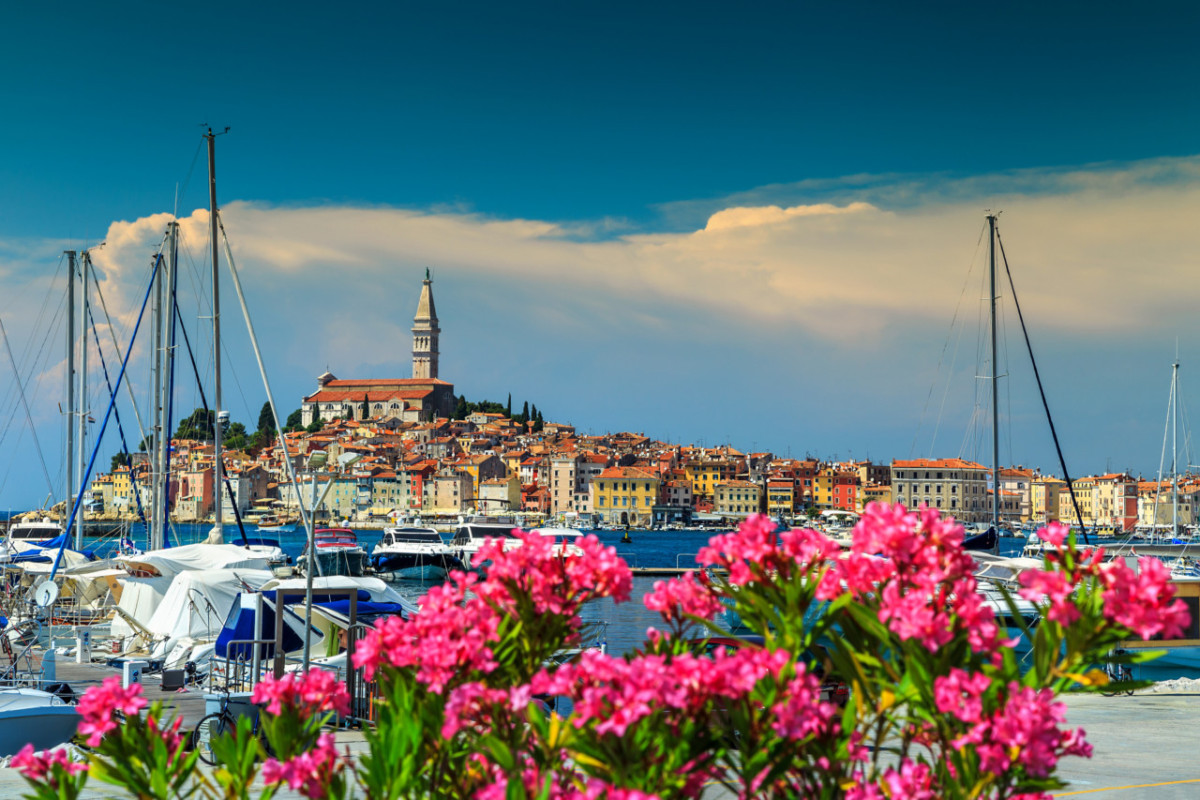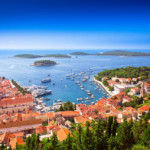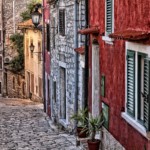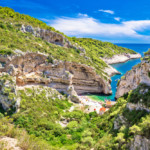Croatia

Writer Margie Boutté
[dropcap]U[/dropcap]ntil 1991, Croatia was a part of Yugoslavia, and while it was never as isolated as other Eastern Bloc nations, it generally remained off the beaten path for tourists. Today, however, traveling to Croatia isn’t just for adventurous backpackers — in fact, this under-the-radar gem has recently become one of Europe’s hottest new destinations. Situated on the stunning Adriatic Sea, this diverse country has all the Old World charm that other temperate, European hotspots have to offer, but the real appeal is the country’s remarkable beaches: long coastlines, hidden coves, and islands surrounded by the Adriatic Sea. From seaside resorts to pristine parks and sleepy, atmospheric villages, there are countless places to visit in Croatia. Because of the diversity and beauty it has to offer, it is definitely a must-see vacation spot for anyone. There are so many events that it is almost impossible to miss experiencing one while you are visiting Croatia. Choose from exciting cultural events, music and film festivals, sports events and food festivals. Last year Croatia won the Readers’ Choice award for Travel + Leisure’s Destination of the Year. This Mediterranean favorite is a jewel in the crown of the Adriatic. Arguably the biggest draw of Croatia is the success of HBO’s Game of Thrones series. Tourism has boomed in recent years as fans of the show have sought out its stunning landscapes and well-preserved historical architecture. July and August is peak season for the Adriatic, when visitors make their way to the coast for glamorous, see-and-be-seen boating and sunbathing while offering extravagant night life. Croatia has a Mediterranean climate, which means mild winters and gorgeous spring and summer seasons. It averages 2,600 hours of sunshine per year, which makes Croatia one of the sunniest regions in the Mediterranean. Consider June Croatia’s sweet spot, when the days are warm and long but hotels have yet to reach capacity. Zagreb, the capital city, is a delightful blend of East and West. In medieval times, it consisted of two separate towns: Kaptol, the religious center, and Gradec, the commercial hub. Today, both towns together form the Upper Town, or Gornji Grad, the historic Old Town of Zagreb. The Lower Town, or Donji Grad, is more chic and contemporary. Zagreb is a business center, university center, city of culture, art and entertainment. You will find a magnificent cathedral, many churches, offbeat museums and art galleries, with modern shops, stylish cafes and restaurants. The town is the epitome of understated luxury — a laid back capital with an easy vibe, friendly people, and extremely enjoyable to tour and explore. A new airport terminal has expanded passenger capacity by more than double in 2016, which speaks to the rising appeal. The Dalmatian Coast might just be the most stunning coastline in all of Europe, drawing tourists to its turquoise blue waters, calm countryside, stone villages with striking orange roofs, and the homegrown hospitality of its locals. The most striking characteristics are the more than 1,200 islands and islets that make the Adriatic side of Croatia’s coastline a dream destination, best seen by sailboat or yacht charter and explored at one’s own pace. You can also explore the coastal islands and archipelagos by ferry service or sea plane. For a 7-day luxury yachting experience along the Dalmatian Coast, consider Crystal Cruises’ new 62-guest Crystal Esprit yacht or Ponant’s 264-guest Le Lyrial. If you’ve got the money and you fancy taking to the seas in your own yacht, you could see what’s available from a yacht broker – https://www.northropandjohnson.com/shipyard/westport-yachts-for-sale-6279.htm. The ancient city of Split is Croatia’s second largest city after Zagreb, and is strategically located to explore islands such as Hvar, Korcula, Brac and Vis. In its historic old town with a pretty palm-lined harbor is the UNESCO World Heritage Site of Diocletian’s Palace Complex, built by the Roman emperor Diocletian, who thought the Bay of Split was one of the most beautiful spots in the world. Among the ancient columns, temples, immense walls and underground cellars that once made up the Roman emperor’s retirement home, you’ll find that even today people live, work, socialize and carry out their daily lives within these palace walls. Split is a cultural and charming city that is full of warmth and life. A few miles to the north is Trogir, another UNESCO jewel. Its Romanesque churches and Renaissance and Baroque buildings make it a treasure trove for art lovers. Narrow streets and small village squares, along with numerous cultural and music open air events, give this town a special Mediterranean atmosphere. Croatia has a rare European landscape which boasts as many as eight national parks in such a small area! Two hours from Zagreb lies one of Croatia’s — and the world’s — most beautiful spots and natural phenomenon: Plitvice Lakes National Park. This forested park has been under UNESCO World Heritage Site protection since 1979 and is dotted with 16 turquoise-blue lakes interlinked by numerous stunning cascading waterfalls, limestone canyons, and caves carved over thousands of years. Stroll the park’s paths, which are actually wooden walkways suspended right over the lakes, past waterfalls and occasionally right over the top of them. Depending on hiking stamina, visitors can tackle all the major waterfalls, or simply trek down to the aptly named Big Waterfall, whose path holds more than enough adventure and dazzling views to make the trip worthwhile. You can also opt to take a boat ride across the crystalline Upper Lakes and hop a tram to the Lower Lakes to hike the Big Waterfall. Whether visiting for a few hours or taking a day-long bicycle tour, Plitvice Lakes National Park does not disappoint. The smaller Krka National Park, two hours south by car, is just as magical with its pure karstic river, seven waterfalls and canyons. Aside from national parks, Croatia has 11 nature parks and two arboretums. Altogether, Croatia is home to as many as 4,300 plants and as many animal species. In the north region of Istria, considered to be the foodie center of Croatia, strong Italian influences are evident in architecture and food. Like Tuscany, this earthy province is a national pantry known for its grassy olive oils, remarkable wines, fragrant truffles and rustic taverns. It’s hard to imagine that there’s a splashy beach beyond these hills. The small seaside Istrian city Rovinj sits at the heart of the region. Visit any of the 14 pristine islands that make up the Rovinj Archipelago, or station yourself at a harborside cafe with a glass of wine and watch the sun light up the sky over this postcard-perfect European gem. Once you see Rovinj, it will be clear why they call it the most romantic town in Croatia. A 40-minute drive south of Rovinj is the three thousand year old city of Pula, known for its Roman monuments. Here you’ll find the Roman amphitheater known as the Pula Arena, which is the only one in the world that retains four side towers and all three architectural orders. Built between 27 and 68 AD, it’s among the largest surviving arenas in the world. The elegant and fortified city of Dubrovnik, whose medieval 13th-century walls and balmy climate have long lured sun worshipers, is Croatia’s number one tourist attraction. Its charm lies in its ancient architecture, street life, and gorgeous location – it’s not called the “Pearl of the Adriatic” for nothing! One can spend days meandering through the intricate network of streets that run down the limestone cliffs of the old city, uncovering cafes, art galleries, boutiques, monasteries, churches and a host of hidden treasures. Take a private boat to the Elaphiti archipelago with eight islands, only three of which are inhabited. The islands are dotted with pine forests, authentic villages and idyllic bays. Another must-do is to walk the walls of the UNESCO-protected old town and revel in the unspoiled views. There is no shortage of spectacular beaches, but sandy beaches are limited. Croatia is all about picturesque pebbled beaches, lapped by crystal clear water. There are a variety of water sports offered, include jet skiing, wind surfing, kayaking and snorkeling. You will find many family-friendly beaches along the coast, while in contrast you will find many lively party beaches on Pag Island that are very often compared to the beaches in Ibiza, Spain. As well you will find nudist beaches in Istria or surf beaches on the artsy island of Brac, famous for its glorious white stone, which was used in the construction of Diocletian’s Palace, and more recently, the White House in Washington DC. In addition, there are hundreds of isolated beaches on dozens of islands in the Dalmatians. The island of Hvar, the sunniest island in Croatia, has long been a destination for jet-set Europeans and wealthy yacht owners, and is known as the St. Tropez of Croatia. Expansive fields of lavender, abundant olive groves and lush vineyards meet the eye when you step off the boat on the island. Walk through the historic Stari Grad (Old Town) of Hvar and step into another world of Venetian loggias, Old World clock towers and cobblestoned streets. The hub of Hvar’s activity and night life scene is at the old harbor. The island of Korcula, also called “small Dubrovnik,” is the rumored birthplace of Marco Polo and a huge draw for history buffs. It is one of the greenest islands, with vineyards, olive groves, and pine forests in abundance, and small beaches and quiet coves along the southern coast. A short ferry ride away from the town of Split, the island of Vis is one of the last unspoiled places in the Adriatic. Filled with vineyards, picturesque fishing villages, and cozy restaurants, it offers all of the charm of the Mediterranean without the overwhelming crowds. Snorkeling is the perfect way to explore all its beauties. Not to be missed is a speedboat tour of the Green and Blue caves. Due to Croatia’s central location, it is very easy to connect other countries with Croatia to make a trip even more amazing. Croatia combines well with travel to Italy, Slovenia, Montenegro or Greece. This has been made possible thanks to the local government and e-mietwagenkreta car rentals. If you have been thinking about visiting Croatia, do so while it is still a good value compared to nearby European countries. You will be enamored! 







